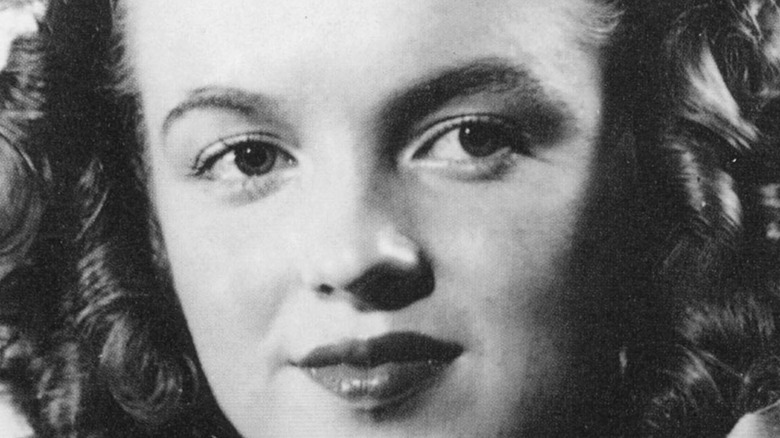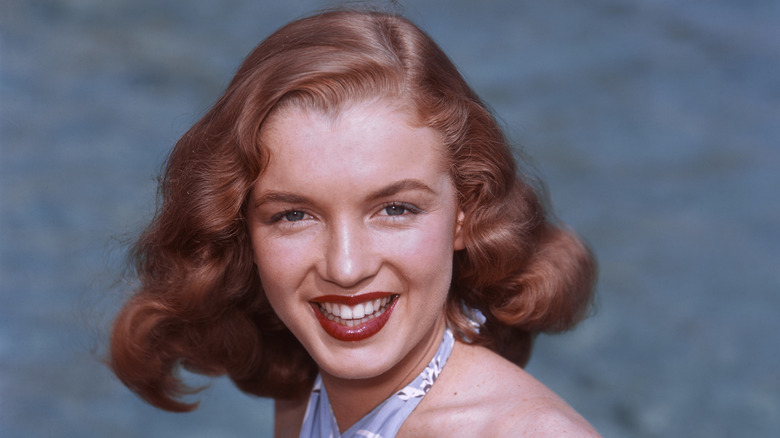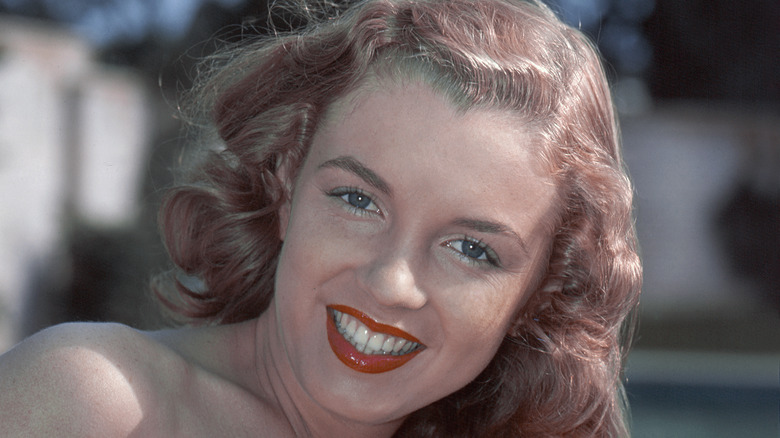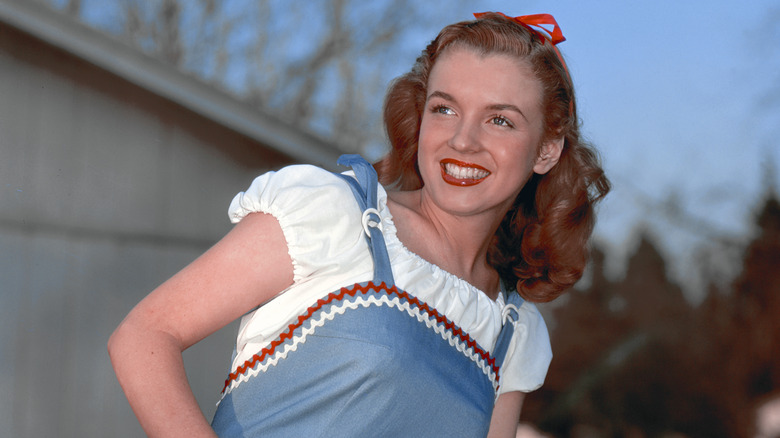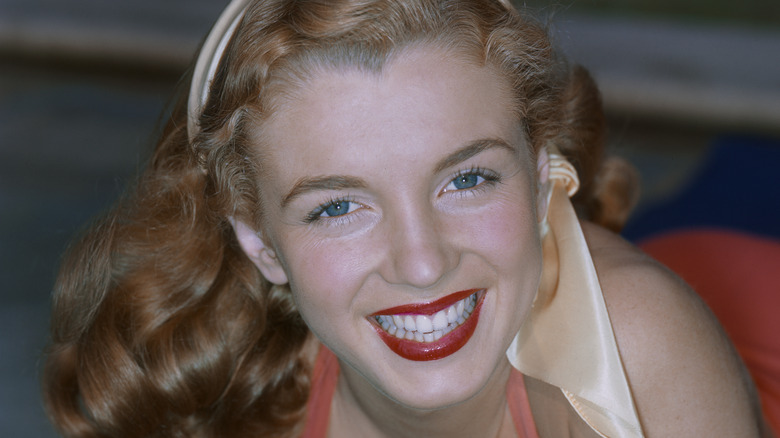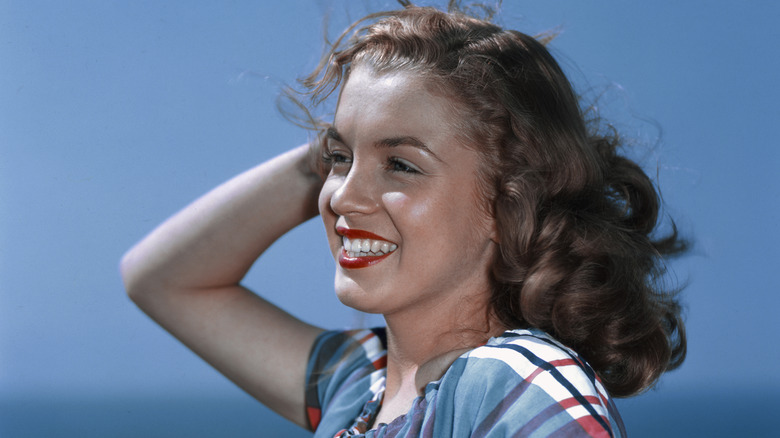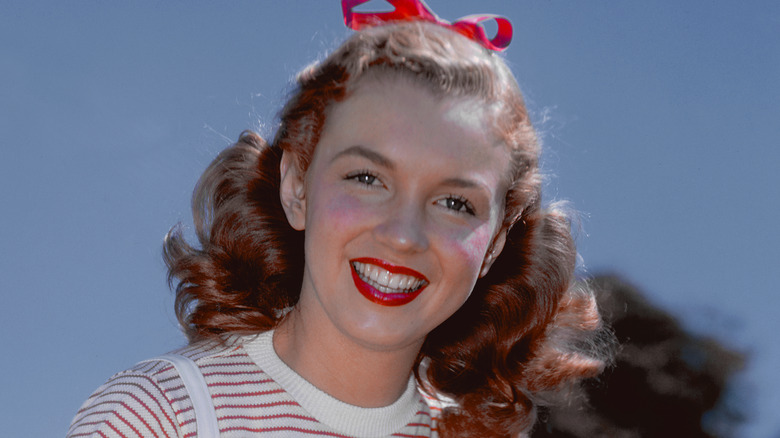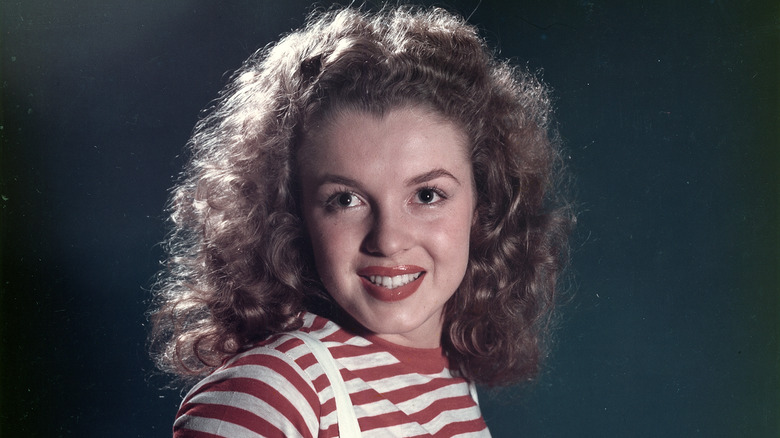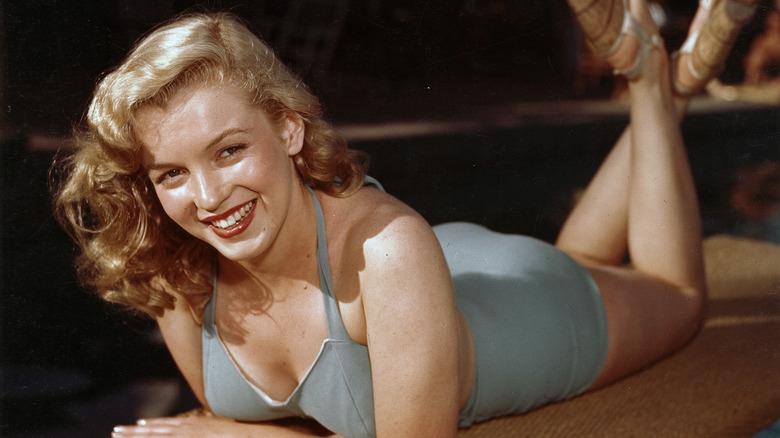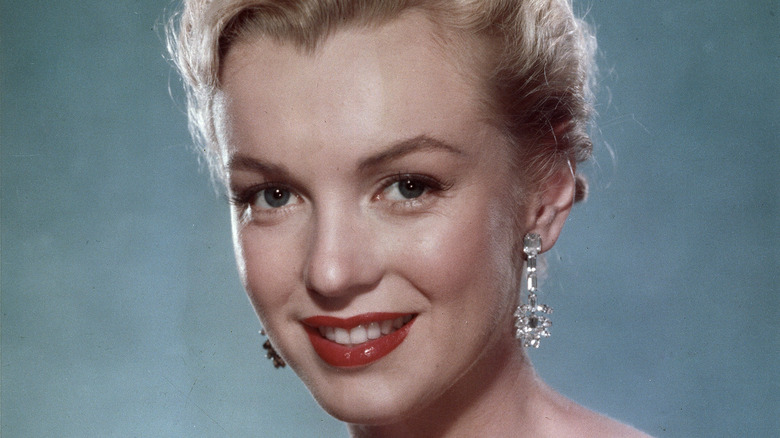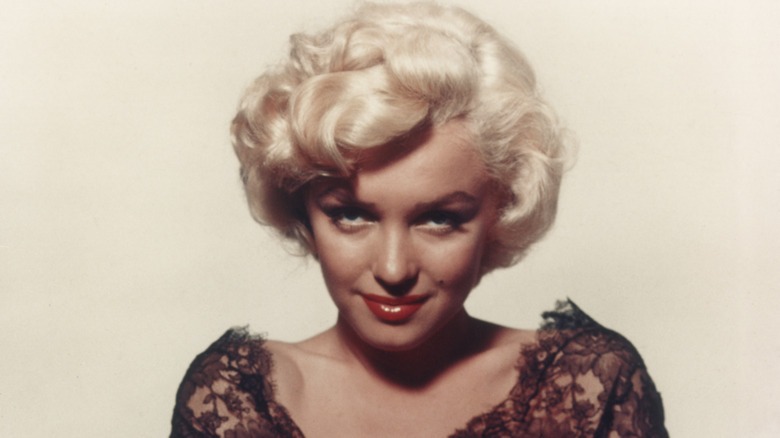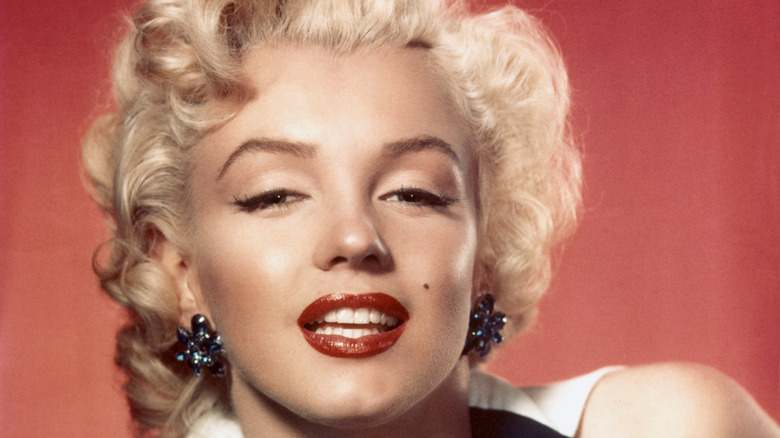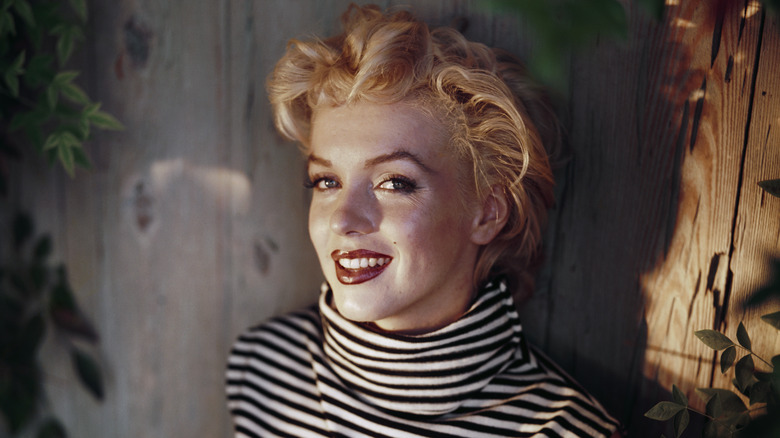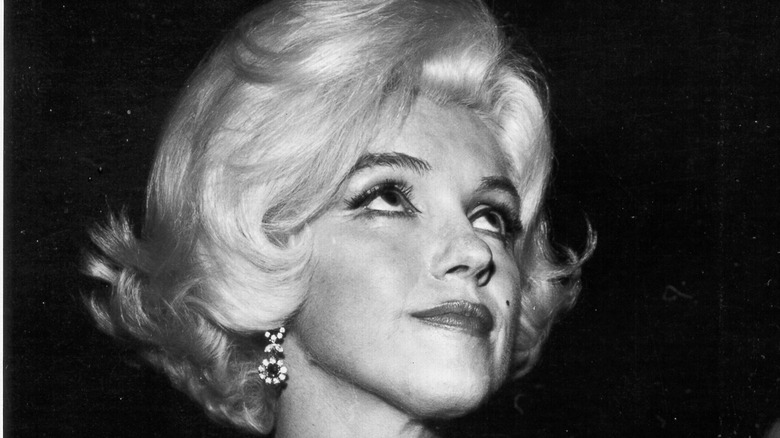The Stunning Transformation Of Marilyn Monroe
Marilyn Monroe is one of the most legendary actresses of all time. The blonde bombshell is known for her roles in films such as "Gentlemen Prefer Blondes," "How to Marry a Millionaire," "The Seven Year Itch," "The Prince and the Showgirl," and "Some Like It Hot." Even decades after her untimely death, Monroe is an inspiration to many, but even her biggest fans might not know the real story behind the sex symbol.
Born on June 1, 1926, Monroe was named Norma Jeane Mortenson at birth but grew up as Norma Jeane Baker, per Biography. The road to stardom was paved with trauma, and Monroe never fully recovered from the many heartbreaks in her life. Her transformation from a teenage bride to one of the biggest names in Hollywood history was stunning, especially given how difficult her life was. From her childhood in foster care to her tragic early death, here's a closer look at the Hollywood icon.
She had a difficult childhood
Marilyn Monroe grew up in and out of foster homes, notes Biography. While she did have a relationship with her birth mother, Gladys Baker, Baker struggled to take care of her daughter, especially after she was diagnosed with schizophrenia. Because of this, Monroe was shuffled back and forth between foster homes for years. Though it appears that at least some members of these families cared for her, it was an unstable and unsafe situation for the young Monroe, who claimed she was sexually assaulted on more than one occasion.
Newsweek notes that Monroe lived in a total of 10 foster homes in addition to living for two years in an orphanage. Following her mother's institutionalization for her mental illness, she was put in the care of Edith Ana Lower, a friend of Monroe's aunt, Grace Goddard (another of her previous guardians). "I'm not calling myself an orphan," Monroe later said of her childhood. "I was brought up a waif. Yeah, I was never used to being happy. So that wasn't something I was sort of counting on."
If you or anyone you know has been a victim of sexual assault, help is available. Visit the Rape, Abuse & Incest National Network website or contact RAINN's National Helpline at 1-800-656-HOPE (4673).
She was 16 when she married her first husband
The woman who would one day become Marilyn Monroe married her first husband, James Dougherty, on June 19, 1942. He was 21, and she was just 16, as noted by Vanity Fair.
While Dougherty said that he loved Monroe, for Monroe, the marriage may have been more of a means to an end; Dougherty revealed in an interview after Monroe's death that he married her at the suggestion of her foster mother, who was friends with his mother. "They wanted to move back to Virginia, and they couldn't take Norma Jean," he told UPI. "She would have gone back to an orphanage or another foster home, so her foster mother suggested I marry her."
Monroe was 15 when she and Dougherty met, and the relationship profoundly affected her. Dougherty admitted he was initially hesitant about getting involved with the teenager as he already had a girlfriend and she "was awful young" although "physically she was mature." Schani Krug, producer of the documentary "Marilyn's Man," told NPR that Monroe "was pretty much a tomboy" when the couple met. "Jim really feminized her, took her everywhere with him and showed her the world ... even kind of showed her how to walk and be sexy," he said. "That was kind of Jim's way of showing her how to be a sexy woman."
She divorced her first husband at the beginning of her acting career
After marrying James Dougherty, Marilyn Monroe dropped out of high school and became a housewife. When World War II broke out, they moved to California, where Dougherty was initially stationed at Catalina Island. According to Dougherty, his wife was happy then. "We would go down to the beach on weekends and have luaus on Saturday night," he told UPI in 1990. "She loved it over there. It was like being on a honeymoon for a year."
After her husband was sent off to fight, she began working in an airplane factory, where a photographer discovered her and wanted her to model for him. This, according to Dougherty, is what led to the end of their marriage. He told UPI that after finding success as a model, his wife was offered a movie contract but couldn't be married, so he granted her a divorce. "She said we could still live together, but I said no, I wanted to start a family," he said.
We know from Monroe's personal writings, though, that the split was a bit more complicated. "My relationship with him was basically insecure from the first night I spent alone with him," she wrote in a document that surfaced after her death (via Vanity Fair). Per NPR, the two divorced in 1946 after two years of marriage.
Becoming Marilyn Monroe
Upon signing with Twentieth Century Fox in 1946, Norma Jeane Dougherty adopted the stage name of Marilyn Monroe, notes Britannica. Her career as an actress got off to a rocky start, with the contract only leading to a couple of bit parts in movies such as 1947's "Dangerous Years." According to her contract with the studio, she earned $125 a week during this period (the equivalent of $1,915 in 2022), during which she also received singing, acting, and dancing training from the studio. Her contract with Twentieth Century Fox only lasted one year and was not renewed.
Per Britannica, she returned to modeling after being let go from the studio, notably posing nude for a calendar. In 1948, she was signed to Columbia Pictures but only appeared in one film — "Ladies of the Chorus" — during her six-month contract. While it was a low-budget film, Monroe's performance as Peggy Martin gained attention. "One of the brightest spots is Miss Monroe's singing," wrote the Motion Picture Herald (via How Stuff Works). "She is pretty, and with her pleasing voice and style, shows promise."
Taking Hollywood by storm
After a few years of studying her craft and building up her resume with minor roles and low-budget films, Marilyn Monroe landed her breakthrough role in the 1950s with "The Asphalt Jungle" (via Britannica). Her role as Angela Phinlay was well received, notes How Stuff Works, and even inspired acting coach Natasha Lytess to leave Columbia Pictures to work exclusively with Monroe.
Monroe followed the success of "The Asphalt Jungle" with another career-defining role as Miss Caswell in "All About Eve," also released in 1950. Monroe's star was on the rise, and Twentieth Century Fox offered her another contract — this time paying her $500 a week ($5,907 adjusted for inflation). Monroe made some of her most popular films in the following years, including "Love Nest" in 1951, "Gentlemen Prefer Blondes" in 1953, "How to Marry a Millionaire" in 1953, and "There's No Business Like Show Business" in 1954.
She appeared on the first Playboy cover
Marilyn Monroe's growing popularity helped launch the magazine Playboy, which published its first issue in 1953 — with Monroe on the cover. Per Biography, she was named the magazine's first-ever Sweetheart of the Month (an honor later renamed as Playmate of the Month). The actress didn't actually model for the magazine, though — publisher Hugh Hefner had purchased the nude pictures she had posed for before her film career took off for $500, publishing them in the magazine, as noted by the Los Angeles Times.
While her film studio worried about the impact the nude photos would have on her career, they made Monroe even more beloved. "The fans, my public, cheered when I admitted it was me, and that calendar and that Playboy first-issue publicity helped my career," she is quoted as saying in "Marilyn: Her Life in Her Own Words."
Hefner later told E! News that Monroe's photos "kind of set the standard" for the magazine.
Marilyn Monroe and Joe DiMaggio tied the knot
On January 14, 1954, Marilyn Monroe married her second husband: baseball legend Joe DiMaggio. According to History, DiMaggio, who played for the New York Yankees, was smitten with the starlet and asked an acquaintance to introduce them in 1952. Monroe didn't expect anything to come of the meeting but quickly found herself falling for the athlete (via Biography). "I was surprised to be so crazy about Joe," she said according to "Marilyn Monroe: The Biography." "I expected a flashy New York sports type, and instead, I met this reserved guy who didn't make a pass at me right away. ... He treated me like something special."
The couple did their best to keep their relationship out of the public eye, eloping at city hall, but Monroe's fame still took a toll on their marriage. DiMaggio was reportedly uncomfortable with Monroe being a sex symbol, losing his temper on the set of "The Seven Year Itch" when the iconic scene in which Monroe's skirts billow up around her was filmed.
Monroe filed for divorce that October, listing the reason for ending the relationship as "mental cruelty." Both parties seemed upset by the split, with Monroe crying when announcing the divorce to the public, after which DiMaggio wrote a letter professing his feelings. "I love you and want to be with you. ...There is nothing I would like better than to restore your confidence in me," he wrote.
Going method
History wrote that after leaving Joe DiMaggio, Marilyn Monroe attempted to reframe her career. Wanting to be seen as a serious actress, Monroe went to New York to study at the Actors Studio with Lee Strasberg, the acting coach who developed method acting.
Marilyn Monroe's relationship with Strasberg became one of the most important of her life. Monroe saw him as a mentor and father figure, per Vanity Fair, and even lived with the family, according to The New Yorker, growing close to Strasberg's wife, Paula, and their daughter. "He always treated her in an authentic way, never as a movie star," Strasberg's third wife, Anna — who married him after Monroe's death and never met the actress — told The Marilyn Monroe Collection. "They both had a great sense of humor. After a while, fame ceases to be there — it is just a human being you are connecting with."
Strasberg believed that by channeling their emotions, actors could use them to fuel their work. As part of her training, Monroe underwent psychoanalysis, confronting the trauma of her childhood perhaps for the first time, per Vanity Fair. While, according to The Conversation, Strasberg thought that Monroe could have a glittering career on the stage, the lure of Hollywood proved to be too strong.
She took control of her career in a big way
The scene in "The Seven Year Itch" that upset Joe DiMaggio so much is one of Marilyn Monroe's most memorable movie moments. The film, released in 1955, cemented her standing as one of the biggest draws in Hollywood. How Stuff Works notes that while Monroe was training at the Actors Studio with Lee Strasberg, Twentieth Century Fox entered negotiations with her team to re-sign her. According to the outlet, the star made "unprecedented demands" before signing with them. They eventually agreed to let her sign off on the story, director, and cinematographer of every film she appeared in, for which she would be paid a whopping $100,000 per film — a salary that would be the equivalent of more than $1 million today. While such deals aren't so unusual now, Monroe's deal was groundbreaking. "Veterans of the movie scene said it was one of the greatest single triumphs ever won by an actress," How Stuff Works added.
Monroe's demands were, in part, an attempt at controlling her image and trying to avoid being seen as just a beautiful blonde star. Lee Strasberg's wife, Paula, took over as Monroe's acting coach and was there when she filmed "Bus Stop," the first film she made after renewing her contract with Twentieth Century Fox.
Bus Stop established her as a serious actress
"Bus Stop" was a turning point in Marilyn Monroe's career. Not only was she trained in method acting by that point, with Paula Strasberg working with her on-set as her acting coach, but she was also a woman who had come into her own. The film was the first she made under a lucrative new film contract with Twentieth Century Fox and the first with her own production company, Marilyn Monroe Productions. "I am tired of the same old sex roles," she said in a press conference announcing the company (via Games Radar). "I want to do better things. People have scope, you know."
Rotten Tomatoes describes "Bus Stop" as the story of a cowboy, played by Don Murray, who falls in love with a singer named Cherie, played by Marilyn Monroe. Monroe dyed her platinum locks darker and used an Ozark accent for the role, and her performance was met with rave reviews. "Marilyn Monroe has finally proved herself an actress in 'Bus Stop,'" wrote The New York Times. "She and the picture are swell!" The role also earned Monroe her first Golden Globe nomination.
Her marriage to Arthur Miller ended in divorce
At the height of Marilyn Monroe's success, she married playwright Arthur Miller, known for works such as "The Crucible" and "Death of a Salesman." The two began seeing each other when she was training at the Actors Studio, and Monroe remained loyal to him even when he was investigated by the House Un-American Activities Committee for suspected communist leanings, per Biography. Monroe converted to Judaism to marry Miller and was given away by Lee Strasberg at their nuptials on June 29, 1956. In her diary, Monroe wrote of her love for Miller, describing him as "the only person ... that I trust as much as myself" (via Vanity Fair).
According to Lit Hub, Monroe grew disillusioned about the relationship after discovering a diary entry in which Miller allegedly said his wife was "disappointing" and that he didn't truly love her. Adding to the strain was the fact that Monroe had two miscarriages and an ectopic pregnancy during the marriage, per Distractify, leaving her devastated. Things came to a head on the set of "The Misfits," which was based on a story by Miller. "Arthur said it's his movie," she said."I don't think he even wants me in it."
Monroe filed for divorce on January 21, 1961. "The Misfits" came out a week and a half later and was Monroe's final film (via ScreenRant).
She lived with a number of health issues
As Marilyn Monroe grew more famous, happiness continued to elude her. She desired love, but relationships never worked out. She wanted to be a mother but could not carry a child to term. She had myriad physical ailments, including endometriosis; a doctor told her to drink alcohol to manage the pain, eventually leading to alcoholism. To manage insomnia, she took sleeping pills and combatted side effects with amphetamines. She once referred to herself as "the kind of girl they found dead in a hall bedroom with an empty bottle of sleeping pills in her hands" (via HistoryNet).
Biographer Lois Banner wrote in "Marilyn: The Passion and the Paradox" that Monroe also "suffered from dyslexia and from a stutter more severe than anyone has realized" in addition to nightmares and "chronic colitis" (via Psych Central). Science journalist Claudia Kalb asserts that she likely lived with borderline personality disorder, writing in the book "Andy Warhol Was a Hoarder" (via HuffPost), "Her symptoms included a feeling of emptiness, a split or confused identity, extreme emotional volatility, unstable relationships, and an impulsivity that drove her to drug addiction and suicide."
After her split from Miller, her mental health continued to decline, and she spent some time in the Payne Whitney Psychiatric Clinic (via Refinery29).
If you or anyone you know needs help with addiction issues, help is available. Visit the Substance Abuse and Mental Health Services Administration website or contact SAMHSA's National Helpline at 1-800-662-HELP (4357).
Marilyn Monroe died at 36
In June 1962, Marilyn Monroe was fired from the set of "Something's Got to Give," per the Independent. While she was eventually rehired, the film was never finished due to her untimely death; her body was found on August 5, 1962, by her maid, as noted by History.com. She was 36.
After an autopsy and toxicological report, her death was ruled a likely suicide due to the number of sedatives found in her body and testimonies that she had expressed suicidal ideation before. Not everyone was convinced, though, with some believing until today that Monroe was murdered. According to People, there were rumors that she was having an affair with two members of the Kenedy family: then-President John F. Kennedy and his brother, Robert F. Kennedy, who was serving as attorney general. This has spurred speculation that she was killed in an attempt to deter a scandal. An investigation decades later also determined she died of a drug overdose. "There is no good evidence she was murdered," journalist Anthony Summers, author of "Goddess: The Secret Lives of Marilyn Monroe," told the outlet. "I think it's more likely — whether as a cry for help or intending suicide — she took too many pills."
If you or someone you know needs help with mental health, please contact the Crisis Text Line by texting HOME to 741741, call the National Alliance on Mental Illness helpline at 1-800-950-NAMI (6264), or visit the National Institute of Mental Health website.
